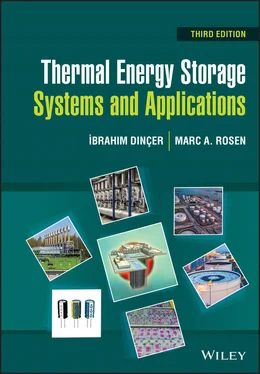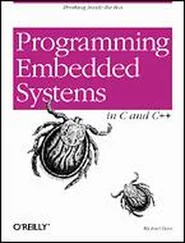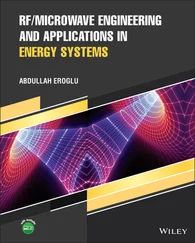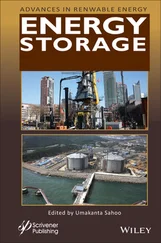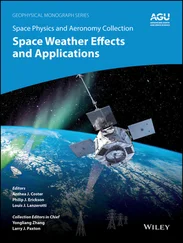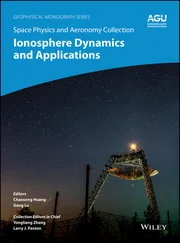Ibrahim Dincer - Thermal Energy Storage Systems and Applications
Здесь есть возможность читать онлайн «Ibrahim Dincer - Thermal Energy Storage Systems and Applications» — ознакомительный отрывок электронной книги совершенно бесплатно, а после прочтения отрывка купить полную версию. В некоторых случаях можно слушать аудио, скачать через торрент в формате fb2 и присутствует краткое содержание. Жанр: unrecognised, на английском языке. Описание произведения, (предисловие) а так же отзывы посетителей доступны на портале библиотеки ЛибКат.
- Название:Thermal Energy Storage Systems and Applications
- Автор:
- Жанр:
- Год:неизвестен
- ISBN:нет данных
- Рейтинг книги:4 / 5. Голосов: 1
-
Избранное:Добавить в избранное
- Отзывы:
-
Ваша оценка:
- 80
- 1
- 2
- 3
- 4
- 5
Thermal Energy Storage Systems and Applications: краткое содержание, описание и аннотация
Предлагаем к чтению аннотацию, описание, краткое содержание или предисловие (зависит от того, что написал сам автор книги «Thermal Energy Storage Systems and Applications»). Если вы не нашли необходимую информацию о книге — напишите в комментариях, мы постараемся отыскать её.
Provides students and engineers with up-to-date information on methods, models, and approaches in thermal energy storage systems and their applications in thermal management and elsewhere Thermal Energy Storage: Systems and Applications
Thermal Energy Storage: Systems and Applications, Third Edition
Thermal Energy Storage Systems and Applications — читать онлайн ознакомительный отрывок
Ниже представлен текст книги, разбитый по страницам. Система сохранения места последней прочитанной страницы, позволяет с удобством читать онлайн бесплатно книгу «Thermal Energy Storage Systems and Applications», без необходимости каждый раз заново искать на чём Вы остановились. Поставьте закладку, и сможете в любой момент перейти на страницу, на которой закончили чтение.
Интервал:
Закладка:
Table of Contents
1 Cover
2 Title Page
3 Copyright Page
4 Preface
5 Acknowledgments
6 1 Basic Introductory Thermal Aspects1.1 Introduction 1.2 Systems of Units 1.3 Fundamental Properties and Quantities 1.4 General Aspects of Thermodynamics 1.5 General Aspects of Fluid Flow 1.6 General Aspects of Heat Transfer 1.7 Concluding Remarks Nomenclature Greek Letters Subscripts and Superscripts References Study Questions/Problems
7 2 Energy Storage Systems2.1 Introduction 2.2 Energy Demand 2.3 Energy Storage Basics 2.4 Energy Storage Methods 2.5 Hydrogen for Energy Storage 2.6 Comparison of ES Technologies 2.7 Energy Storage and Environmental Impact 2.8 Environmental Impact and Energy Storage Systems and Applications 2.9 Potential Solutions to Environmental Problems 2.10 Sustainable Development 2.11 Concluding Remarks References Study Questions/Problems
8 3 Thermal Energy Storage Methods3.1 Introduction 3.2 Thermal Energy 3.3 Thermal Energy Storage 3.4 Solar Energy and TES 3.5 TES Methods 3.6 Sensible TES 3.7 Latent TES 3.8 Cold TES (CTES) 3.9 Seasonal TES 3.10 Concluding Remarks References Study Questions/Problems
9 4 Energy and Exergy Analyses4.1 Introduction 4.2 Theory: Energy and Exergy Analyses 4.3 Thermodynamic Considerations in TES Evaluation 4.4 Exergy Evaluation of a Closed TES System 4.5 Appropriate Efficiency Measures for Closed TES Systems 4.6 Importance of Temperature in Performance Evaluations for Sensible TES Systems 4.7 Exergy Analysis of Aquifer TES Systems 4.8 Exergy Analysis of Thermally Stratified Storages 4.9 Energy and Exergy Analyses of Cold TES Systems 4.10 Exergy‐Based Optimal Discharge Periods for Closed TES Systems 4.11 Exergy Analysis of Solar Ponds 4.12 Concluding Remarks References Study Questions/Problems Appendix: Glossary of Selected Exergy‐Related Terminology
10 5 Numerical Modeling and Simulation5.1 Introduction 5.2 Approaches and Methods 5.3 Selected Applications 5.4 Numerical Modeling, Simulation, and Analysis of Sensible TES Systems 5.5 Case Studies for Sensible TES Systems 5.6 Numerical Modeling, Simulation, and Analysis of Latent TES Systems 5.7 Case Studies for Latent TES Systems 5.8 Illustrative Application for a Complex System: Numerical Assessment of Encapsulated Ice TES with Variable Heat Transfer Coefficients 5.9 Thermal Performance Assessment of Geometrically Modified Ice Capsules During Discharging 5.10 Concluding Remarks Nomenclature Greek and Special Symbols Subscripts Acronyms References Study Questions/Problems
11 6 Thermal Management with Phase Change Materials6.1 Introduction 6.2 Thermal Management 6.3 Thermal Management Methods 6.4 Case Studies 6.5 Concluding Remarks Nomenclature Greek Letters Subscripts Acronyms References Study Questions/Problems
12 7 Renewable Energy Systems with Thermal Energy Storage7.1 Introduction 7.2 Renewable Energy Sources and Systems 7.3 Renewable Energy with Energy Storage 7.4 Case Study 1: Solar Energy System with Thermal Energy Storage 7.5 Case Study 2: Solar Energy‐Based System with Compressed Air Energy Storage 7.6 Case Study 3: Combining Wind and Current Turbines with Pumped Hydro Storage 7.7 Concluding Remarks References Problems
13 8 Case Studies8.1 Introduction 8.2 Ice CTES Case Studies 8.3 Ice‐Slurry CTES Case Studies 8.4 Chilled Water CTES Case Studies 8.5 PCM‐Based CTES Case Studies 8.6 PCM‐Based Latent TES for Heating Case Studies 8.7 Sensible TES Case Studies 8.8 Other Case Studies 8.9 Concluding Remarks References Study Questions/Problems
14 Index
15 End User License Agreement
List of Tables
1 Chapter 1 Table 1.1 Some of the most common thermocouples. Table 1.2 Equations for gas and gas mixtures and relevant models. Table 1.3 Comparison of Dalton and Amagat models. Table 1.4 Relations among essergy, availability, exergy, and free energy. Table 1.5 Comparison between energy and exergy. Table 1.6 Values of laminar boundary‐layer thicknesses for laminar flow over ... Table 1.7 Momentum equations for laminar boundary layer. Table 1.8 Momentum equations for a turbulent boundary layer for flat plate fl... Table 1.9 Some of the most important heat transfer dimensionless parameters. Table 1.10 Natural convection heat transfer equations and correlations. Table 1.11 Forced‐convection heat transfer equations and correlations.
2 Chapter 2 Table 2.1 Some materials for flywheels and their properties. Table 2.2 Some batteries and their capacities. Table 2.3 Comparison of conventional sealed lead–acid battery with the horizo... Table 2.4 Mid‐ and long‐term goals of the USABC in early 2000. Table 2.5 Technical comparison of ES technologies. Table 2.6 Capital costs and efficiencies for ES devices. Table 2.7 Main gaseous pollutants and their impacts on the environment. Table 2.8 Roles of some substances in the greenhouse effect.Table 2.9 UN Sustainable Development Goals for 2015–2030.
3 Chapter 3Table 3.1 Storage durations for small‐ and large‐scale applications.Table 3.2 Comparison of potential TES implementation in France and the USA.Table 3.3 Thermal and technical data for selected TES techniques.Table 3.4 Sample TES cycle characteristics.Table 3.5 Available media for sensible and latent TESs.Table 3.6 Thermal capacities at 20 °C of some common TES materials.Table 3.7 Types and features of various stratified TES tanks [14].Table 3.8 Some possible heat sources and heat users for ATES.Table 3.9 Measured thermophysical data of some PCMs.Table 3.10 Main commercial PCM suppliers [13].Table 3.11 Commercially available PlusICE™ substances.Table 3.12 Details for chiller A (38 L/s).Table 3.13 Design and operational loads and TES system parameters.Table 3.14 Flow, temperature and pressure parameters.Table 3.15 Energy demand and usage.
4 Chapter 4Table 4.1 A reference‐environment model.Table 4.2 Base enthalpy and chemical exergy values of selected species.Table 4.3 Two overall energy ( η ) and exergy ( ψ ) TES efficiencies.Table 4.4 Some exergy‐related thermodynamic considerations in TES system eval...Table 4.5 Comparison of the performance of a TES for two cases.Table 4.6 Summary of possible efficiency definitions for closed TES systems. ...Table 4.7 Efficiency values (in %) for the illustrative example.Table 4.8 Relation between several temperature parameters for above‐environme...Table 4.9 Values of the ratio ψ / η for a range of practical values fo...Table 4.10 Specified general data for the example.Table 4.11 Results for the stratification example.Table 4.12 Specified temperature data for the cases in the CTES example.Table 4.13 Energy and exergy quantities for the cases in the CTES example.Table 4.14 Specified and evaluated data for the ITES case study.Table 4.15 Parametric results [122].Table 4.16 Selected properties of materials comprising and surrounding experi...Table 4.17 Mean monthly temperatures (in °C) of solar pond zones and surround...Table 4.18 Mean monthly exergy parameters (in MJ) for solar pond zones.
5 Chapter 5Table 5.1 Cell distribution for the three cases considered in the grid indepe...Table 5.2 Properties of heat transfer fluids.Table 5.3 Properties of capsule wall and phase change materials (PCMs).Table 5.4 Numerically obtained parameters and heat transfer coefficients for ...Table 5.5 Geometrical specifications of the ice capsules considered in the ca...Table 5.6 Physical properties of the substances encountered in the case study...
6 Chapter 6Table 6.1 Thicknesses and thermal conductivities of selected materials.Table 6.2 Thermodynamic properties at state points for the system in Figure 6...Table 6.3 Thermal properties and sizes of components used in the simulation.
7 Chapter 7Table 7.1 Thermodynamic properties of selected molten salts at 1 atm and 300°...Table 7.2 Thermodynamic properties of selected molten salts at 1 atm and 500°...Table 7.3 Design parameters of the solar energy‐based integrated system using...Table 7.4 Thermodynamic properties for state points in the integrated system ...Table 7.5 Work and heat rates of the main components.Table 7.6 System parameters considered for the case study.Table 7.7 Process data of the integrated solar energy‐based system using CAES...Table 7.8 Average wind speeds for the selected area in Istanbul.Table 7.9 Main assumptions and results for case study.
Читать дальшеИнтервал:
Закладка:
Похожие книги на «Thermal Energy Storage Systems and Applications»
Представляем Вашему вниманию похожие книги на «Thermal Energy Storage Systems and Applications» списком для выбора. Мы отобрали схожую по названию и смыслу литературу в надежде предоставить читателям больше вариантов отыскать новые, интересные, ещё непрочитанные произведения.
Обсуждение, отзывы о книге «Thermal Energy Storage Systems and Applications» и просто собственные мнения читателей. Оставьте ваши комментарии, напишите, что Вы думаете о произведении, его смысле или главных героях. Укажите что конкретно понравилось, а что нет, и почему Вы так считаете.
